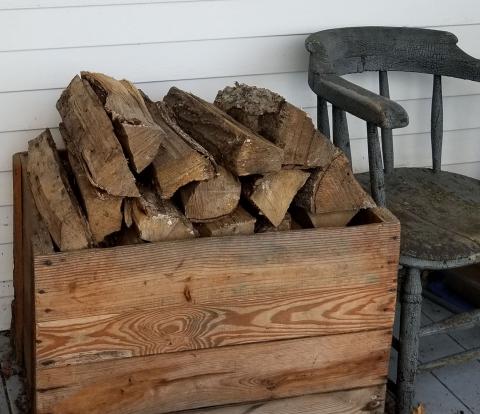Gifts from Trees

During the recent holiday season, we gave thanks for what we have and gave gifts to friends and family. But all year round we receive gifts from trees that we often take for granted.
There’s a long list of the gifts that trees give us – clean air and water, places to recreate, wildlife habitat, carbon storage, and watershed protection. And we can harvest trees for a multitude of wood products and still protect all these values at the same time – this is what forestry is all about, after all.
One morning, while walking back to the house with a wheelbarrow load of firewood, I looked around at the many gifts that trees give us in the form of wood. The firewood that heats our home is just one. The pile of leftover bark that will be made into mulch is another. Walking up the front steps (made of wood), I put the firewood pieces into a wooden box that sits on the wood porch. Opening the door to our wood-framed house, I passed the holiday wreath made of balsam fir boughs. Stepping over the wood threshold, I walked into the room where the woodstove sits, and stopped to look around at all the things made from trees. The Christmas tree in the corner, with some wooden ornaments hanging on it; trim and molding around the room’s edges; window frames; shelves; chairs, tables, a bench, the box for kindling; books, magazines, and paper; even the wallpaper. Not to mention the studs, subfloors, and floor joists hidden from view.
Other things that are made from trees that can be found in our house or on our property are cutting boards, spoons, rolling pins, guitars, toys, a swing set, the barn, a canoe and paddles, frames for the raised garden beds, pallets stacked with firewood, and plenty of other items. I’m sure there are many more that I’m not even thinking of. And beyond wood, there’s the maple syrup we make from sap each spring. The list goes on when we expand the boundaries of where we’re looking.
All of these things are made from trees, which we use in our daily lives, some of which are essential to society as we know it. And since I’m fortunate to live in a rural area, when I look outside I mostly see forests. The story of forests in the United States is one of net expansion over the last 100 years, not one of loss. And every year we harvest less, in some places significantly less, than growth. Through various factors, such as improved knowledge of how to manage sustainably for not only timber but wildlife habitat and recreation, plus more efficient utilization of the trees that we do harvest, forests have been able to expand. We’ve also been able to set more areas aside that will not be harvested at all. So despite all the products made from wood that we all use every day, we’ve still been able to expand the territory of forests for all the things for which we value them.
Take a look around sometime, and count up all of the items surrounding you that are made from trees. And take a minute to appreciate all the gifts of trees, and the efforts of many to ensure that we can enjoy these gifts in perpetuity.
